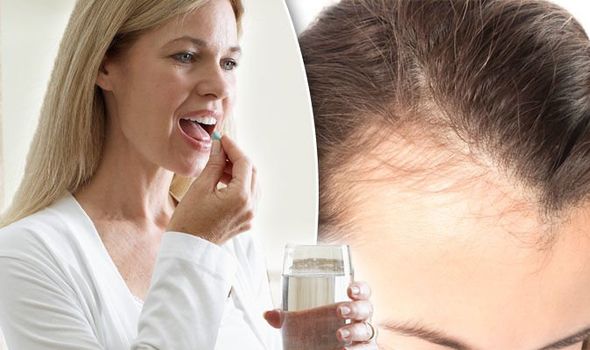Vitamin D deficiency - does your hair look like this? Warning signs of deficiency revealed

VITAMIN D deficiency symptoms include muscle pain, excessive sweating, and often developing a cold. But you could also be at risk of deficiency signs, and should add more vitamin D foods to your diet, if your hair looks like this.
Vitamin D is needed to help keep your muscles, bones and teeth healthy, according to the NHS.
If you don’t get enough vitamin D in your diet, it’s difficult to regulate the amount of calcium or phosphate in the body.
A severe lack of vitamin D can even lead to some other complications, including deformities, rickets or osteomalacia.
Vitamin D is used by the body to help with the hair growth cycle, which may be the cause behind the link, it said.
While more research is needed, it’s still best to make sure you have enough vitamin D in your diet, said the clinic.
“There have been numerous studies into the effects vitamin D has on our general health, most notably it plays a vital role in bone health and the prevention of cardiovascular disease and diabetes.
“However, recent studies have also found a link between vitamin D and hair loss, namely whether having a vitamin D deficiency can result in hair falling out.
“The most recent study looked at women with hair loss, and does indicate that those women experiencing hair loss had much lower vitamin D levels than normal.
Furthermore, increasing hair loss and disease severity caused the vitamin D levels to decrease further.
“Vitamin D works alongside a number of different vitamins and minerals, including iron, vitamin C and biotin, which are all vital in the hair growth cycle, so gaining a better understanding of all these elements will shed more light into the connection.”
You could also be at risk of a vitamin D deficiency if you have a strange pain in your bones.
The pain may feel like it’s throbbing, and left untreated, it could develop into osteoporosis, and an increased risk of fractures.
Consider increasing your vitamin D intake if you have bone pain, along with a general feeling of weakness.
Other common vitamin D deficiency symptoms include having an overwhelming feeling of fatigue and excessive sweating.
The best way to avoid a deficiency is to spend between 20 and 30 minutes in direct sunlight.
But, during the winter months, it’s not possible to absorb enough ultraviolet light to produce vitamin D.
Therefore, everyone should consider taking vitamin D supplements from September to March to prevent a deficiency.
If supplements aren’t for you, try eating more oily fish or red meat, as they’re rich in vitamin D.
https://www.express.co.uk/life-style/health/1065679/vitamin-d-deficiency-symptoms-signs-hair-loss-food-diet
Vitamin D is needed to help keep your muscles, bones and teeth healthy, according to the NHS.
If you don’t get enough vitamin D in your diet, it’s difficult to regulate the amount of calcium or phosphate in the body.
A severe lack of vitamin D can even lead to some other complications, including deformities, rickets or osteomalacia.
Vitamin D is used by the body to help with the hair growth cycle, which may be the cause behind the link, it said.
While more research is needed, it’s still best to make sure you have enough vitamin D in your diet, said the clinic.
“There have been numerous studies into the effects vitamin D has on our general health, most notably it plays a vital role in bone health and the prevention of cardiovascular disease and diabetes.
“However, recent studies have also found a link between vitamin D and hair loss, namely whether having a vitamin D deficiency can result in hair falling out.
“The most recent study looked at women with hair loss, and does indicate that those women experiencing hair loss had much lower vitamin D levels than normal.
Furthermore, increasing hair loss and disease severity caused the vitamin D levels to decrease further.
“Vitamin D works alongside a number of different vitamins and minerals, including iron, vitamin C and biotin, which are all vital in the hair growth cycle, so gaining a better understanding of all these elements will shed more light into the connection.”
You could also be at risk of a vitamin D deficiency if you have a strange pain in your bones.
The pain may feel like it’s throbbing, and left untreated, it could develop into osteoporosis, and an increased risk of fractures.
Consider increasing your vitamin D intake if you have bone pain, along with a general feeling of weakness.
Other common vitamin D deficiency symptoms include having an overwhelming feeling of fatigue and excessive sweating.
The best way to avoid a deficiency is to spend between 20 and 30 minutes in direct sunlight.
But, during the winter months, it’s not possible to absorb enough ultraviolet light to produce vitamin D.
Therefore, everyone should consider taking vitamin D supplements from September to March to prevent a deficiency.
If supplements aren’t for you, try eating more oily fish or red meat, as they’re rich in vitamin D.
https://www.express.co.uk/life-style/health/1065679/vitamin-d-deficiency-symptoms-signs-hair-loss-food-diet
